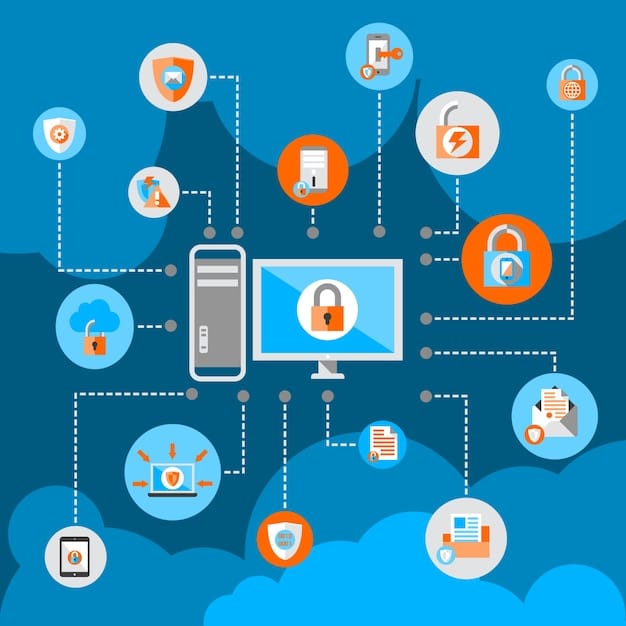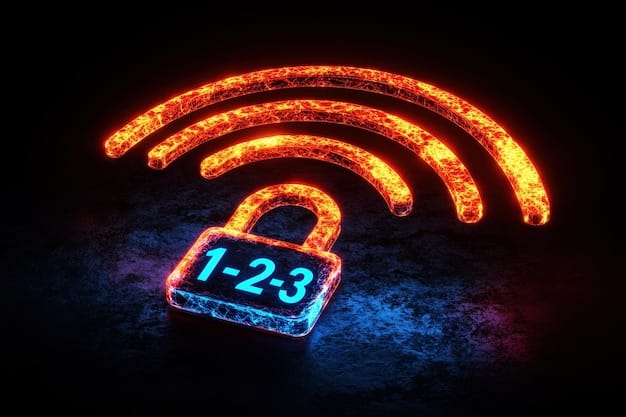Streaming Security: Protecting Your Privacy While You Watch in 2025

Streaming security is increasingly important in 2025. Protecting your personal data while enjoying streaming services requires understanding privacy settings, using strong passwords, and employing VPNs.
In the ever-expanding world of streaming entertainment, **streaming security: protecting your privacy while you watch** has become a crucial concern. We are spending countless hours streaming movies, TV shows, and music, but how secure is your personal information during these sessions? This article will guide you through the essential steps to ensure your streaming experience remains private and secure in 2025.
Understanding the Risks of Streaming
Streaming services have revolutionized how we consume media, offering unparalleled convenience and access to a vast library of content. However, this convenience comes with inherent risks. From data breaches to privacy intrusions, understanding these risks is the first step in securing your streaming experience.
Data Breaches and Account Hijacking
One of the most significant risks associated with streaming is the potential for data breaches. Streaming platforms store a wealth of personal information, including your name, email address, payment details, and viewing history. If a platform experiences a data breach, this information could fall into the wrong hands.
- Account Security: Weak passwords and password reuse make your accounts vulnerable to hijacking.
- Phishing Scams: Cybercriminals often use phishing tactics to trick users into revealing their login credentials.
- Data Tracking: Streaming services track your viewing habits to personalize recommendations, but this data can also be used for other purposes without your explicit consent.
Account hijacking is another common issue, where unauthorized users gain access to your streaming accounts. This can lead to unauthorized purchases, exposure of your viewing history, and even identity theft. Taking proactive steps such as enabling two-factor authentication and regularly monitoring your account activity can mitigate these risks.

Privacy Intrusions and Data Collection
Beyond data breaches, streaming services collect vast amounts of data about your viewing habits. This data is used to personalize recommendations, but it can also raise privacy concerns. Understanding how your data is collected and used is essential for maintaining control over your personal information.
Streaming platforms collect data such as what shows you watch, when you watch them, and the devices you use. This data is often used to create detailed profiles of your viewing preferences, which can be shared with advertisers or other third parties. By understanding these privacy intrusions, you can take steps to limit the amount of data you share and protect your privacy.
Securing your streaming habits and understanding the associated risks is paramount. From safeguarding against data breaches to taking charge of your data privacy, being proactive can protect your personal information when consuming online content. Knowledge is your most powerful tool in the realm of **streaming security: protecting your privacy while you watch**.
Strengthening Your Streaming Security: Best Practices
Now that you understand the risks associated with streaming, let’s explore actionable steps to enhance **streaming security: protecting your privacy while you watch**. These best practices will help minimize your vulnerability to data breaches and privacy intrusions.
Use Strong, Unique Passwords
One of the most basic yet effective ways to protect your streaming accounts is by using strong, unique passwords. A strong password should be at least 12 characters long and include a combination of uppercase and lowercase letters, numbers, and symbols.
Avoid reusing passwords across multiple accounts. If one of your accounts is compromised, cybercriminals can use the same password to access your other accounts. Using a password manager can help you generate and store strong, unique passwords for each of your streaming services. Regularly updating your passwords and enabling two-factor authentication adds an extra layer of security.
Enable Two-Factor Authentication (2FA)
Two-factor authentication (2FA) adds an extra layer of security to your streaming accounts. With 2FA enabled, you will need to provide a second form of verification, such as a code sent to your phone, in addition to your password.
- Enhanced Security: Reduces the risk of unauthorized access even if your password is compromised.
- Easy Setup: Most streaming platforms offer straightforward 2FA setup processes.
- Account Protection: Helps protect your account from phishing attacks and password breaches.
Enabling 2FA makes it significantly more difficult for cybercriminals to access your account, even if they have your password. Most streaming platforms offer 2FA, so take advantage of this feature to enhance your streaming security.
Employing strong passwords coupled with two-factor authentication forms a robust initial defense against unauthorized account access. By consistently adhering to these fundamental security measures, you establish a strong base for broader **streaming security: protecting your privacy while you watch**.
Securing Your Home Network for Streaming
Your home network is the backbone of your streaming experience. Securing your network is crucial for protecting your streaming activity from eavesdropping and unauthorized access. Here are steps to take to ensure your home network is secure.
Secure Your Wi-Fi Router
Your Wi-Fi router is the entry point to your home network, making it a prime target for cybercriminals. Securing your router is essential for protecting all devices connected to your network, including your streaming devices.
- Change Default Credentials: Always change the default username and password of your router.
- Enable WPA3 Encryption: Use WPA3 encryption for the highest level of security.
- Update Firmware: Regularly update your router’s firmware to patch security vulnerabilities.
Changing the default login credentials prevents unauthorized users from accessing your router settings. Enabling WPA3 encryption ensures that your Wi-Fi connection is secure, preventing eavesdropping. Keeping your router’s firmware up to date patches security vulnerabilities that cybercriminals could exploit. Prioritizing home network protection enhances **streaming security: protecting your privacy while you watch**.

Use a Virtual Private Network (VPN)
A Virtual Private Network (VPN) encrypts your internet traffic and routes it through a secure server, masking your IP address and location. Using a VPN can enhance your streaming security and privacy.
A VPN hides your IP address, making it more difficult for streaming services and cybercriminals to track your location and viewing habits. It encrypts your internet traffic, preventing eavesdropping and protecting your data from being intercepted. Choosing a reputable VPN provider is essential. Look for providers with a no-logs policy, strong encryption, and a proven track record of protecting user privacy. Employing a VPN improves **streaming security: protecting your privacy while you watch** while connecting to public networks.
Securing your home network is paramount for protecting your streaming activities from potential threats. From securing your Wi-Fi router to utilizing a VPN, each measure contributes to a more secure streaming environment. By implementing these strategies, you can maintain a safe online experience while you watch your favorite content. With comprehensive **streaming security: protecting your privacy while you watch**, you can enjoy content with peace of mind.
Privacy Settings and Data Management on Streaming Platforms
Streaming platforms offer various privacy settings that allow you to control how your data is collected and used. Understanding these settings is crucial for managing your privacy.
Review and Adjust Privacy Settings
Take the time to review and adjust the privacy settings on each of your streaming platforms. Most platforms allow you to control what information is shared with third parties, how your viewing history is used, and whether you receive personalized recommendations.
Adjusting these settings can significantly reduce the amount of data you share with streaming services. Be aware that disabling personalized recommendations may affect the quality of your viewing experience, as recommendations may become less relevant. Staying proactive with streaming platform settings reinforces **streaming security: protecting your privacy while you watch**.
Limit Data Sharing with Third Parties
Many streaming platforms share user data with advertisers and other third parties. Limiting data sharing can help protect your privacy and prevent your data from being used for unwanted purposes.
Check the privacy policies of your streaming platforms to understand how your data is shared. Opt out of data sharing whenever possible. Some platforms may offer additional privacy settings that allow you to limit ad tracking and personalized advertising. Control over data sharing enhances **streaming security: protecting your privacy while you watch**.
Taking control of your privacy settings and how the platform manages the data enhances your control over privacy. By understanding the available settings, users can minimize data sharing, and customize privacy settings to their personal preferences. This awareness of privacy settings advances **streaming security: protecting your privacy while you watch**, giving users more control over their streaming experience.
Staying Informed and Proactive About Streaming Security
The landscape of streaming security is constantly evolving, so staying informed and proactive is essential. Here are some tips for keeping up with the latest security threats and best practices.
Monitor Account Activity Regularly
Regularly monitor your streaming accounts for suspicious activity. Look for unauthorized purchases, changes to your profile, or unfamiliar devices accessing your account.
Most streaming platforms provide tools for monitoring account activity. Set up alerts to notify you of any unusual activity, such as logins from new locations or devices. If you suspect your account has been compromised, change your password immediately and contact the streaming platform’s customer support. Vigilant monitoring supports comprehensive **streaming security: protecting your privacy while you watch**.
Stay Updated on Security Threats
Stay informed about the latest security threats and vulnerabilities affecting streaming platforms. Follow cybersecurity news and blogs, and subscribe to security alerts from your streaming services.
- Cybersecurity News: Keep abreast of emerging threats by following credible cybersecurity news sources and blogs.
- Vendor Alerts: Subscribing to security alerts from your streaming services keeps you informed about the known vulnerabilities
- Community Forums: Join community forums and discussions; exchange tips and insights with security conscious users of the internet.
Staying updated on security threats helps you take proactive steps to protect your streaming accounts. Be wary of phishing scams and other social engineering attacks, and never click on suspicious links or share your login credentials with anyone. Diligence helps you stay informed about the evolving landscape of **streaming security: protecting your privacy while you watch**.
Remaining informed means that one consistently monitors accounts and remains updated on security threats, which is essential in protecting streaming activities. Implementing these practices ensures users can safeguard their streaming effectively. With active monitoring and awareness, you stay safe while enjoying your favorite shows with enhanced **streaming security: protecting your privacy while you watch**.
| Key Point | Brief Description |
|---|---|
| 🔑 Strong Passwords | Using strong, unique passwords for each streaming account. |
| 🛡️ Two-Factor Authentication | Enabling 2FA to add an extra layer of security. |
| 🌐 VPN Usage | Using a VPN to encrypt your internet traffic and hide your IP address. |
| ⚙️ Privacy Settings | Reviewing and adjusting privacy settings on streaming platforms. |
Frequently Asked Questions
Protecting your privacy while streaming is important because streaming platforms collect personal data that could be vulnerable to breaches or misuse. Using strong passwords and enabling 2FA can substantially reduce the risk.
A robust password includes diverse characters—uppercase and lowercase letters, numbers, and symbols— totaling at least 12 characters. Avoid using the same password that you use elsewhere, and updating periodically.
Two-factor authentication (2FA) adds an additional security layer with SMS codes or verification apps, ensuring only the authorized user enters the streaming service account.
A VPN encrypts your internet traffic, masking your IP address and location. This can prevent streaming services and cybercriminals from tracking your viewing habits. It is also helpful when using public Wi-Fi, where security may be weak.
Review and adjust privacy settings to limit data shared with third parties. You can restrict ad tracking and personalized recommendations to minimize data collection and maintain control over your personal details.
Conclusion
In conclusion, **streaming security: protecting your privacy while you watch** demands constant attention and an awareness of the latest cybersecurity landscape. By using robust passwords, enabling two-factor authentication, and managing your privacy settings, you can enjoy streaming without unnecessary risk.
Keeping yourself informed and staying proactive will enhance your enjoyment of digital entertainment in a secure environment. Apply these strategies to navigate the streaming world safely. Enhance your comprehensive **streaming security: protecting your privacy while you watch** and stream safely into 2025.





